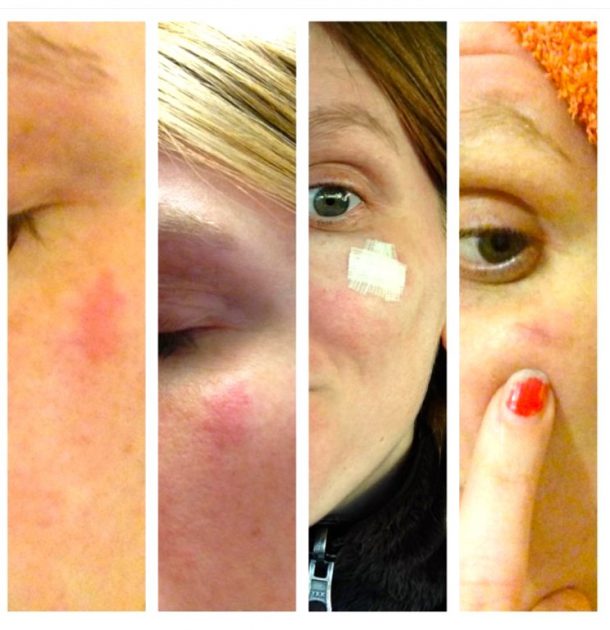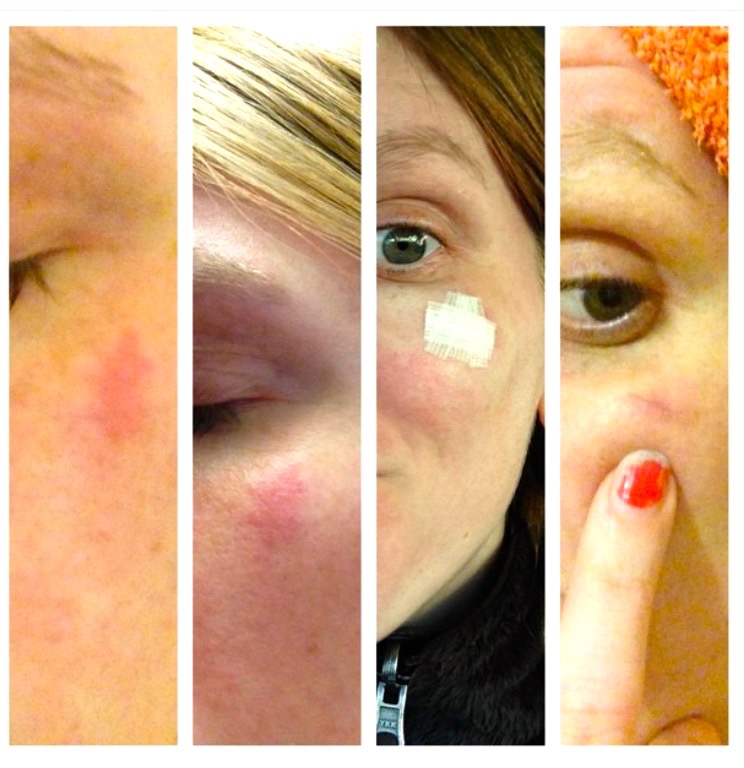By Diana Palka
January 2013. I woke up and began my morning routine. I was 23, working full-time, living at home – it looked a lot like this: get out of bed, brush teeth, walk downstairs, have coffee with mom, go upstairs, moisturize (because I am a compulsive moisturizer), do hair and makeup, get dressed.
This morning was unlike most others throughout the each of my steps – except when I moisturized. As I gently rubbed the cream under my eyes, I noticed a red patch of skin under my left eye that stung. At first I thought it was a scratch, but upon closer examination I noticed it wasn’t open at all. I remembered that I’d actually seen this red patch of skin every few months or so; in the same spot, this red, dry and irritated patch of skin no larger than a sunflower seed would surface under my left eye.
Because this time it was particularly painful and seemed a little closer to my eye, I assumed I had some sort of rash or allergic reaction. I booked an appointment with my dermatologist.
When I saw the doctor, she did a biopsy, suspecting it was an abnormal cell. “Abnormal cell” didn’t trigger any worry in me. As a fair-skinned, quasi-ginger, I’d been doing preventive skin checks since I was 16. I’d had my share of run-ins with the sun, so my parents always wanted to be sure nothing was going on with my skin. At about almost half of these visits my dermatologist would biopsy something: a mole, an odd-shaped freckle, a birthmark, etc., just to be sure there were no abnormalities. I’d been fortunate enough to have a clean bill of health each time. The nurse would call, say the test came back negative nd I’d be on my way. I thought this biopsy was just another cautionary measure so we were extra sure I was okay.
Four days after my visit my phone rang and it was the number for my dermatologist’s office. When I picked up and heard my doctor’s voice instead of the nurse, I knew something was up.
“Diana, we got your biopsy back and it’s actually a squamous cell carcinoma. This is a form of skin cancer that you’ll have to get removed through a Mohs surgery.”
I calmly got the information to schedule the procedure and then – shaking — ducked into an empty conference room to call my mom, in tears. The word cancer scared me and I couldn’t believe what I just heard.
In the two weeks that followed the call and before the procedure, I was see-sawing between calm and panic. In one moment I was able to convince myself it was no big deal and I’d be fine – in the very next I’d believe the absolute worst case scenario. Admittedly, I also wrestled with the realization that I was infinitely vainer than I ever imagined. (Truth? You don’t realize how vain you are until you’re 23 and someone tells you they’re going to take a surgical knife to your cheek.)
When the day for the out-patient Mohs procedure came, I felt a sense of relief. Nervous on the table, the entire ordeal was fairly painless and took only about 30 minutes to complete. I was stitched up by a plastic surgeon (hey, vanity!).
It was determined I had Actinic Keratosis (AKs) on my right cheek. AKs are “pre-cancerous” cells that turn into squamous cell carcinomas, if left untreated. Because this was likely caused by the same sun damage that caused the squamous cell carcinoma, that was treated, too.
Though it didn’t require a Mohs surgery, the treatment was almost worse. For 14 days, I had to apply an anti-cancer drug to the affected area, twice a day. The goal of this drug is to burn out and kill the bad cells before they start to spread. My skin burned from the inside out and on day 7, I had an open wound the size of a golf ball on my cheek. The cream continued to burn out the bad cells for the remainder of the 14 days and by the end, my cheek was raw. (If you’re keeping up, vanity has gone out the window at this point.)
The scab took almost two months to heal; I’m told the drug did its job in seeking out the bad cells.
The reality is my run in with skin cancer was mild, at worst. It was caught early, easily treated, and created only minimal disruption in my life. The truth is some skin cancers aren’t this innocuous. Some are more serious. Some require multiple surgeries. Some aggressively spread.
Skin cancer is real; most are preventable. In fact, roughly 90 percent of non-melanoma skin cancers are associated with exposure to ultraviolet radiation from the sun. With a little knowledge and a self-care, most skin cancers can be avoided.
Find a sunscreen that works for you and be diligent about wearing it.
You’re out there running, riding, swimming, sweating…and exposed to the sun. The entire time. Some days, this means hours of direct exposure. Be smart. Find a broad spectrum sunscreen that works for you and use it as directed. Go ahead, laugh. I use 100 SPF Neutrogena Ultra-Sheer with Helioplex Technology and I love it!
Know your skin.
Do skin checks. Regularly. In the shower, in front of a mirror, at your desk at work, wherever. Check between your toes, check your lips, check the tops of your ears, have someone check your scalp. Know what’s normal, so you can spot what’s not.
Get checked.
Get a full body check at least once a year – more frequently if you are pre-disposed to skin cancers. Talk to your doctor. Establish a relationship. Yes, these exams are invasive and tedious – but it beats the unpleasant alternatives.
# # #
Diana Palka is a Charlotte-based writer; runner; lover of grace, craft beer and the well-written. She has an unbreakable rule that there are three things in life you never buy cheap: shoes, beer and toilet paper. When not working as a Marketing / Communication consultant in Corporate America, she writes for kicks and giggles at www.dianapalka.com.







